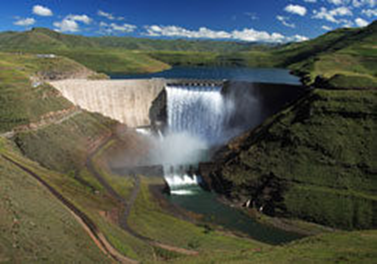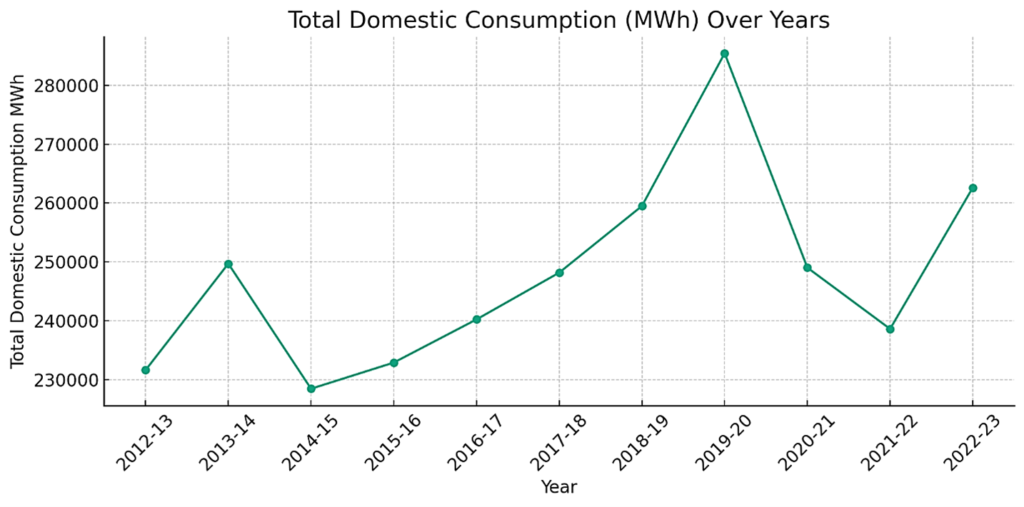Lesotho’s Affluence of Water and Wind Resources and Energy Poverty Tale
Moeketsi Kali writes on the history of water and wind resource use in Lesotho and ongoing energy access inequalities.
Lesotho is known as the “Water Tower of Southern Africa,” due to its abundant water resources that give it a high potential to generate abundant hydroelectricity. Its high-altitude geography with an extensive network of rivers and mountain terrain also lends it a potential to generate electricity from wind. The largest river basin in Africa, the Senqu River, originates in Lesotho and is shared by multiple downstream countries such as South Africa, Botswana, and Namibia (Vinti, 2021). Due to its water resource opulence, Lesotho engages in bilateral agreements with downstream countries to ensure sustainable transboundary water management and cooperation (Crerar & Weston, 2014).
The Water Tower of Southern Africa has high potential for generating solar, wind, and hydropower, which could surpass its relatively modest energy demands (World Bank, 2020). In fact, the production of energy in the country is classified as one of the greenest in the world. According to Jensen (1987), Lesotho has the potential to exploit hydroelectricity up to 2,000 GWh (450 MW). As per the Energy Catalyst Country Guide for Lesotho in 2020, it has been identified that Lesotho, the Mountain Kingdom, could potentially produce 6,000 MW from wind and 4,000 MW from pumped storage. However, the country is currently only exploiting about 17% of this potential.
Poverty in affluence as manifested in energy access inequality
South Africa is the main beneficiary of water negotiation arrangements with Lesotho, as it relies on water transferred from the Lesotho Highlands Water Project (LHWP). In return, Lesotho benefits from a modicum of power generation for its local citizens through this project. The LHWP is a binational project between the Government of Lesotho and the Government of South Africa, aiming to supply sustainable water to South Africa and generate hydro-power for Lesotho (Liphoto, 2020). In the meantime, several Basotho communities helplessly gaze in thirst at the water pipelines passing by their communities to quench Johannesburg’s thirst.
Despite the benefits derived from water negotiation arrangements, there are concerns that this agreement primarily benefits South Africa.
According to the World Bank (2020), Lesotho’s demand for electricity totals 160 MW, but the country is unable to meet its own demand as more than half is imported from countries like Mozambique and South Africa. The Muela hydropower plant fed by the Katse Dam, with a capacity of 74.7 MW, is the main source of power generation in Lesotho. The country has about 177.32 MW peak power demand and imports more than 100MW (UNDP Lesotho, 2020), only meeting 40% of its electricity demand (World Bank, 2020).

Fig 1. Katse Dam, concrete arch dam on the Malibamat’so River in Lesotho, is Africa’s second largest double-curvature arch dam. Completed in 1996. Source: https://southafricatoday.net/africa-news/southern-africa/lesotho/lesotho-highlands-water-project-phase-ii-to-be-completed-by-2023/
Gendered energy access and energy inequalities
One of the persisting challenges is the inequality in energy access, particularly in rural areas. The 2017 Households Energy Consumption Survey reveals that Lesotho’s electrification rate stands at 38%, with only 36% of households being grid connected and 2% using solar home systems. The lack of electricity access is more acute in rural communities, where the majority of the population resides (65.8%). As a result, people in these areas rely on traditional biomass, such as firewood and animal waste, for cooking and heating. This situation has led to energy poverty in a water rich country, particularly among women who spend significant time collecting firewood.
The lack of access to modern and clean energy sources in Lesotho may affect the productive capacity of both women and men, but women experience energy poverty differently due to existing gender relations in society. In both urban and rural areas, women play a crucial role in supplying household energy for cooking and heating. Women in urban and rural areas also have different energy experiences. In rural areas, where electricity connectivity is lacking, women primarily depend on firewood, paraffin, and animal waste as the main sources of energy for cooking, lighting, and space heating. It is estimated that they spend approximately five hours a day, twice a week collecting firewood (UNDP Lesotho, 2020).
Electricity access in penury: Could half a loaf be better than no bread?
The cost of electricity access and consumption poses a challenge for most of Basotho. However, even in areas with electricity connectivity, some households lack the financial resources to pay for connection fees and utility bills. According to Mpholo et al. (2018) the Lesotho Electricity Company’s (LEC) data reveals that the average consumption per household has decreased by over 60% between 2001 and 2016 in urban households. Figure 2 illustrates the changing household’s consumption patterns over the years.
Fig 2. Household consumption patterns over the years

Source: Fieldwork (2023).
Most of the households connected to electricity during this period were the rural poor. Despite having electrical connectivity, electricity bills being perceived as more expensive than traditional biomass, lead some households to continue using traditional energy sources. The households’ renewable energy use landscape has been aggravated with the Covid-19 pandemic and prospects of recovery remain unforeseeable.
Conclusion and recommendations
Lesotho faces significant challenges in achieving universal energy access and reducing energy poverty, particularly in rural areas, despite its abundant water resource. While the country has the potential to generate renewable energy, there is a need for increased investment, infrastructure development, and financial support to ensure sustainable energy access for all. Addressing these challenges is crucial to empower both women and men, enhance economic productivity, and improve the overall well-being of the population in Lesotho. The current landscape is not sustainable as energy connectivity does not result in increased consumption. There is a need therefore, to invest in Basotho’s economic empowerment meanwhile ensuring citizen access to renewable energy.
REFERENCES
Bureau of Statistics Lesotho. (2017) Household Energy Consumption Survey Report. https://www.bos.gov.ls/Publications.htm
Crerar, S., & Weston, D. (2014). Integrated Water Resources Management Plan for the Orange-Senqu River Basin. https://renoka.org/wp-content/uploads/2021/08/019_2014_IWRM-Plan-Main-Report.pdf
Jensen, T. (1987). Hydroelectric Power in Lesotho. Water Resources Directorate V-Publication. https://publikasjoner.nve.no/publikasjonV/publikasjonV_03.pdf
Liphoto, M., J. (2020). Exploring the Impacts of the Lesotho Highlands Water Project on the Sustainable Livelihoods of Resettled Communities. https://scholar.sun.ac.za/server/api/core/bitstreams/11a2d01a-e788-40d8-a222-4222a8109a8f/content
Mpholo, M., Meyer-Renshhausen, M., Thamae, R. I, Molapo, T., Mokhuts’oane, L., Taele, B. M., & Maketha, L. (2018) Rural Household Electrification in Lesotho. https://energypedia.info/images/5/52/RERIS_Jan2018_Mpholo.pdf
UNDP Lesotho. (2020). Sustainable Energy for All: Gender Mainstreaming Strategy for the Energy Sector, Lesotho 2020-2024. https://www.undp.org/sites/g/files/zskgke326/files/migration/ls/undp-lesotho-gender–energy-sector-report-2020.pdf
United Kingdom Research and Innovation. (2020). Energy Catalyst Country Guide: Lesotho https://energycatalyst.ukri.org/wp-content/uploads/2023/06/Country-Guide-Lesotho.pdf
Vinti, C. (2021). The Treaty on the Lesotho Highlands Water Project and the Principle of “equitable and reasonable utilisation.” De Jure Law Journal, 328-346. Available at: http://dx.doi.org/10.17159/2225-7160/2021/v54a19
World Bank. (2020). Lesotho Renewable Energy and Energy Access Project. Available at: https://documents1.worldbank.org/curated/en/808341580698850813/pdf/Lesotho-Renewable
